
A birch is a thin-leaved deciduous hardwood tree of the genus Betula, in the family Betulaceae, which also includes alders, hazels, and hornbeams. It is closely related to the beech-oak family Fagaceae. The genus Betula contains 30 to 60 known taxa of which 11 are on the IUCN 2011 Red List of Threatened Species. They are typically short-lived pioneer species and are widespread in the Northern Hemisphere, particularly in northern areas of temperate climates and in boreal climates. Birch wood is used for a wide range of purposes.

Betula pendula, commonly known as silver birch, warty birch, European white birch, or East Asian white birch, is a species of tree in the family Betulaceae, native to Europe and parts of Asia, though in southern Europe, it is only found at higher altitudes. Its range extends into Siberia, China, and southwest Asia in the mountains of northern Turkey, the Caucasus, and northern Iran. It has been introduced into North America, where it is known as the European white birch or weeping birch and is considered invasive in some states in the United States and parts of Canada. The tree can also be found in more temperate regions of Australia.
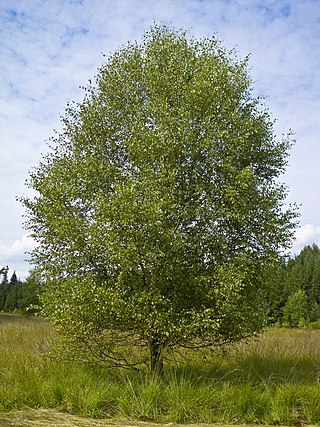
Betula pubescens, commonly known as downy birch and also as moor birch, white birch, European white birch or hairy birch, is a species of deciduous tree, native and abundant throughout northern Europe and northern Asia, growing further north than any other broadleaf tree. It is closely related to, and often confused with, the silver birch, but grows in wetter places with heavier soils and poorer drainage; smaller trees can also be confused with the dwarf birch.

Caloptilia azaleella is a moth of the family Gracillariidae. It is endemic to Japan, but has been introduced worldwide, wherever there are Azaleas.

Caloptilia rufipennella is a moth of the family Gracillariidae that is found throughout Europe.
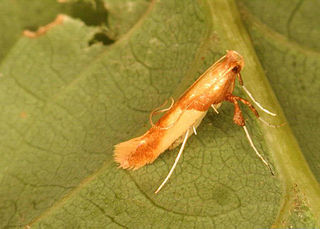
Caloptilia alchimiella is a moth of the family Gracillariidae. It is found in Europe and the Near East.

Caloptilia cuculipennella is a moth of the family Gracillariidae. It is found in Holarctic Region, including most of Europe.

Eriocrania unimaculella is a moth of the family Eriocraniidae found in Europe. It was first described by the Swedish naturalist Johan Wilhelm Zetterstedt in 1839. The larvae feed inside the leaves of birch, making a mine.

Caloptilia populetorum is a moth of the family Gracillariidae. It is found in most of Europe, except Italy, the Balkan Peninsula and the Mediterranean islands.
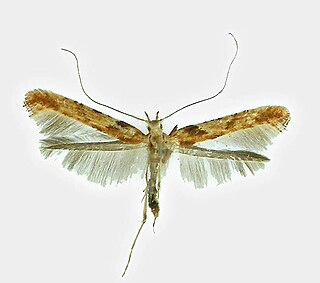
Caloptilia hemidactylella is a moth of the family Gracillariidae. It is mostly found in central and northern Europe, although there are recent records from Belgium and the Netherlands. It is a rare species in Great Britain with no reliable records since the 1950s, when it was recorded in Gloucestershire. It is also believed to have been present in Northamptonshire in the 19th century.
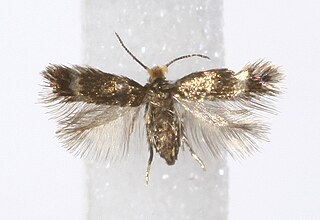
Stigmella betulicola is a moth of the family Nepticulidae. It is found in most of Europe, east to the eastern part of the Palearctic realm.

Stigmella lapponica is a moth of the family Nepticulidae found in Asia, Europe and North America. It was first described by the German entomologist, Maximilian Ferdinand Wocke in 1862. The larvae mine the leaves of birch.
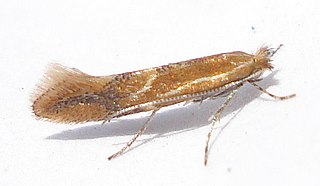
Phyllonorycter corylifoliella, the hawthorn red midget moth, is a moth of the family Gracillariidae. It is found in all of Europe.
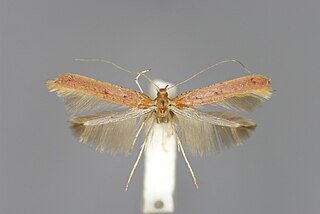
Caloptilia elongella is a moth of the family Gracillariidae. It is known from all of Europe east to eastern Russia. It is also found in North America from British Columbia, south to California and east in the north to New Hampshire and New York.

Caloptilia falconipennella is a moth of the family Gracillariidae. It is known throughout all of Europe, except the Balkan Peninsula.
Caloptilia flava is a moth of the family Gracillariidae. It is known from southern Russia and Rhodes.

Caloptilia robustella is a moth of the family Gracillariidae. It is known from all of Europe, except the Balkan Peninsula.
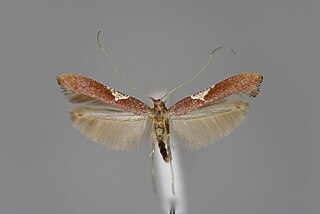
Caloptilia stigmatella is a moth of the family Gracillariidae. It is known from the Holarctic Region, including all of Europe.
Caloptilia pyrrhaspis is a moth of the family Gracillariidae. It is known from China (Sichuan), Japan and the Russian Far East.
Caloptilia alnivorella, the alder leafminer, is a moth of the family Gracillariidae. The species was first described by Vactor Tousey Chambers in 1875. It is known from the Russian Far East, Canada and the United States.


















